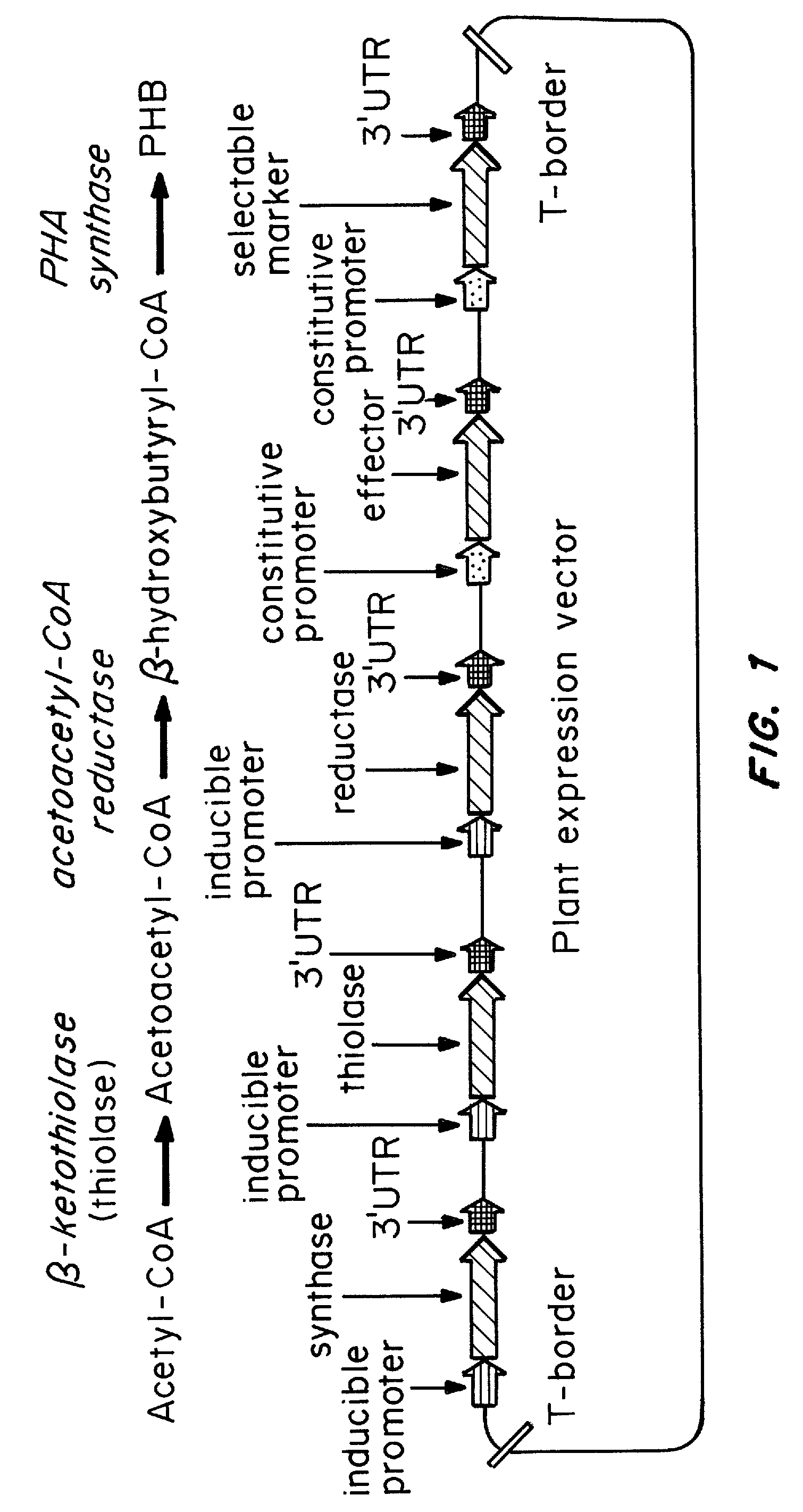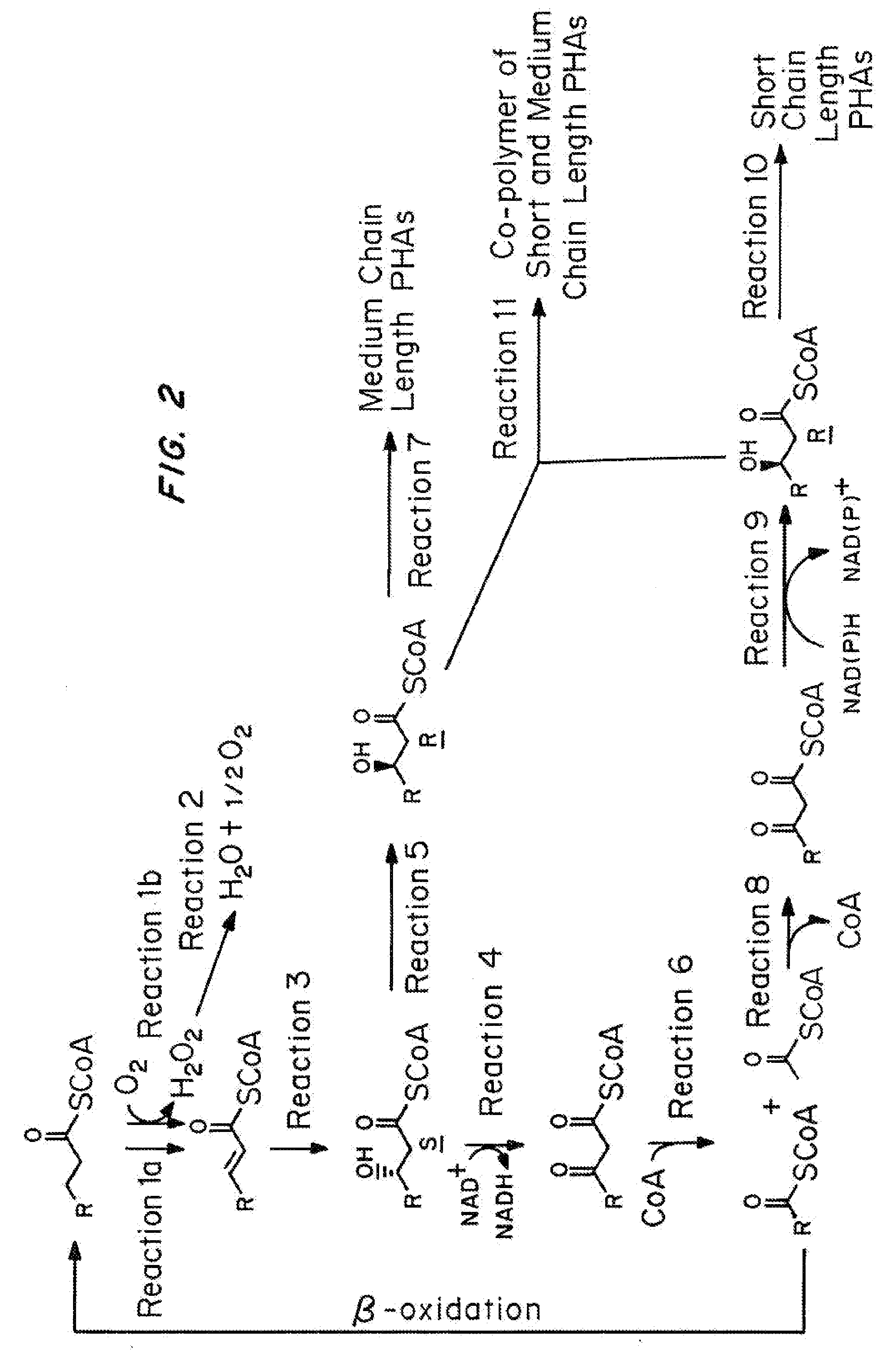Chemically inducible expression of biosynthetic pathways
- Summary
- Abstract
- Description
- Claims
- Application Information
AI Technical Summary
Benefits of technology
Problems solved by technology
Method used
Image
Examples
example 1
Construction of Plasmids
[0092] All DNA manipulations, including PCR, DNA sequencing, transformation, and plasmid purification, were performed using standard procedures, as described, for example, by Sambrook et. al., Molecular Cloning: A Laboratory Manual (Cold Spring Harbor Laboratory Press, New York (1989)).
[0093] pUC18-C4PPDK-AAA-RBS contains the 35S-C4PPDK promoter (Chiu et al. Curr. Biol. 6: 325 (1996)), DNA encoding the signal peptide of the small subunit of rubisco from pea and the first 24 aa of the mature protein (Coruzzi et al. J Biol. Chem. 258(3):1399-1402 (1983)), DNA encoding a three aa linker that contains a Xba I restriction site allowing fusion of the desired transgene, and the 3′ terminator of the nopaline synthase gene (Bevan et al., Nucleic Acids Res. 11(2):369-385 (1983)). This plasmid was constructed using the following multi-step procedure. Oligonucleotides BamXbaNot-A and BamXbaNot-B were annealed and ligated into plasmid pUC18-35S-C4PPDKsGFPnos (Chiu et al...
example 2
Plant Transformation and Induction
[0116] The genes required for the complete PHB production pathway, a ketothiolase (thiolase), an NADPH-acetoacetyl-CoA reductase (reductase) and a PHA synthase (synthase), were individually placed under the control of the minimal 35S ecdysone-inducible promoter, fused to a plastid targeting signal, and cloned into a pCAMBIA (Centre for Application of Molecular Biology to International Agriculture, Canberra, Australia) based multigene plasmid containing the chimeric ecdysone receptor (A. Martinez, C. Sparks, C. A. Hart, J. Thompson, I. Jepson, Plant J. 19: 97 (1999)). This three-gene inducible construct is designated 3I. The single-gene inducible construct designated 1I contained the thiolase gene under the control of the inducible promoter, but unlike the 3I construct, it expressed the reductase and synthase genes under the control of the constitutive 35S-C4PPDK promoter (W. Chiu et al. Curr. Biol. 6: 325 (1996)).
[0117] Transformation of Arabidops...
example 3
Plant PHB Analysis and Extraction
[0119] Fluorescence microscopy with Nile Blue staining was performed as previously described (Poirier et al. Science 256: 520-523 (1992)) with some modifications. Leaf tissue was sliced as thin as possible with a razor blade and fixed in 3% paraformaldehyde (Electron Microscopy Sciences, Ft. Washington, Pa.) in 0.1 M K2PO4, pH 8, for three hours. Fixed samples were washed with water and stained with a previously filtered 1% Nile Blue (Sigma, St. Louis, Mo.) solution for five minutes at room temperature. Samples were washed with water and destained with 8% acetic acid. Samples were washed an additional two times with water. Samples were viewed by fluorescence microscopy on a Zeiss Axiolab light microscope equipped with a Zeiss HBO 100 fluorescence attachment and a 20×Ph-1 lens using the following filter set: exciter, HQ545 / 30; beam splitter, Q570lp; emitter D590 / 20 (Chroma Technology, Brattleboro, Vt.). Images were recorded with a Zeiss MC 80 DX Micr...
PUM
| Property | Measurement | Unit |
|---|---|---|
| Responsivity | aaaaa | aaaaa |
Abstract
Description
Claims
Application Information
 Login to View More
Login to View More - R&D
- Intellectual Property
- Life Sciences
- Materials
- Tech Scout
- Unparalleled Data Quality
- Higher Quality Content
- 60% Fewer Hallucinations
Browse by: Latest US Patents, China's latest patents, Technical Efficacy Thesaurus, Application Domain, Technology Topic, Popular Technical Reports.
© 2025 PatSnap. All rights reserved.Legal|Privacy policy|Modern Slavery Act Transparency Statement|Sitemap|About US| Contact US: help@patsnap.com



